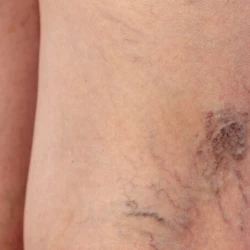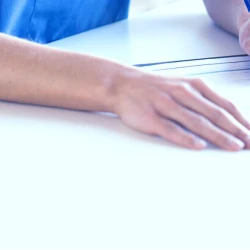You may be entitled to recover compensation and our legal team can help. Please click the button below for a Free Consultation or call us toll-free 24 hrs/day for legal advice by dialing (866) 588-0600.
Deep vein thrombosis is a condition suffered by patients with implanted IVC filters. It happens when a blood clot forms within one or more of the veins in the leg, causing severe leg pain.
Over the years, our team of expert attorneys at Schmidt and Clark has filed hundreds of lawsuits against IVC manufacturers for deep vein thrombosis and yielded positive results in terms of compensation.
Get in touch with us if you have been diagnosed with deep vein thrombosis, and we will walk you through your options and ensure you get compensated for your injury.
Quick Summary
- Deep vein thrombosis could lead to sudden death if left untreated, even when the symptoms have become apparent.
- You should check with a doctor to explore the best treatment options if you suffer from deep vein thrombosis.
- The settlement amount you could get for a deep vein thrombosis lawsuit varies depending on the nature of your case and the extent to which the condition has affected your life.
- IVC filters could cause deep vein thrombosis if they fracture and migrate within your body or if your doctor implants them wrongly.
Table Of Contents
- Quick Summary
- What Is Deep Vein Thrombosis?
- How Do IVC Filters Cause Deep Vein Thrombosis?
- How Do IVC Filters Work?
- Studies That Link IVC Filters With Deep Vein Thrombosis
- IVC Filter Cases That Were Filed for Deep Vein Thrombosis
- Risk Factors Associated With Deep Vein Thrombosis
- Treatments for Deep Vein Thrombosis
- Types of Damages You Can Claim for Deep Vein Thrombosis
- Estimated Settlement Amount for Deep Vein Thrombosis
- FAQs
- Get Your DVT Lawsuit Filed Today!
What Is Deep Vein Thrombosis?
 Deep vein thrombosis is an IVC filter complication that occurs when a blood clot, otherwise known as thrombosis, develops within the veins in your leg, causing you to experience severe leg swelling and pain.
Deep vein thrombosis is an IVC filter complication that occurs when a blood clot, otherwise known as thrombosis, develops within the veins in your leg, causing you to experience severe leg swelling and pain.
This blood clot may ensue if you suffer from a health challenge or during your recovery right after surgery.
When this happens, the blood clot gets loose and migrates through the body straight to the lungs, blocking the blood flow within your body and leading to a condition known as pulmonary embolism.
Besides pulmonary embolism, deep vein thrombosis can cause other symptoms, such as post-thrombotic syndrome, cardiac tamponade, reduced blood circulation, excessive pain, and limited mobility.
Post-thrombotic syndrome is a severe long-term problem when the heart receives limited blood supply, leading to pain and leg ulcers.
Cardiac tamponade, on the other hand, is a situation where the fluid sac around the heart gets filled up with blood or other fluid, leading to excessive pressure on the heart.
How Do IVC Filters Cause Deep Vein Thrombosis?
IVC filters in a bid to prevent the blood clot from affecting your arteries and lungs can sometimes cause deep vein thrombosis.
This could happen if there is an IVC filter fracture and it migrates within the body or if your doctor places it improperly in your body.
Medical studies have shown that patients with IVC implants are most likely suffering from two or more diseases and have a higher risk of malignant neoplasm, stroke, and deep vein thrombosis because of manifestations of pulmonary embolism [1].
How Do IVC Filters Work?
 IVC filters detect blood clots migrating through the inferior vena cava vein. This vein is the largest in the body and very important because it conducts blood from the lower parts of the body to the heart and lungs.
IVC filters detect blood clots migrating through the inferior vena cava vein. This vein is the largest in the body and very important because it conducts blood from the lower parts of the body to the heart and lungs.
To begin with, your surgeon will implant the inferior vena cava filter in your body by making a minor cut in your neck or groin, then insert the filter and use a catheter to direct the device into the inferior vena cava in your abdomen.
Once this is done, the IVC filter then attaches itself firmly to the interior walls of the inferior vena cava vein.
When the IVC filter insertion has been completed, it collects the blood clots as they migrate to the vein. The purpose of this is to ensure that these blood clots do not get to the heart and lungs, which, if they do, could cause blockage and pulmonary embolism.
Studies That Link IVC Filters With Deep Vein Thrombosis
Numerous studies have proven that inferior vena caval filters are linked with deep vein thrombosis.
Here they are below:
- A study titled: Inferior Vena Cava Filter–Related Thrombus/Deep Vein Thrombosis: Data and Management suggests that recurrent deep vein thrombosis and IVC thrombosis are well-recognized complications following IVC filter placement that may lead to significant morbidity and mortality [2].
- A study titled: Management of the Thrombosed Filter-Bearing Inferior Vena Cava revealed that IVC causing deep vein thrombosis is a complex problem and can be cured using endovascular treatments since it is safe and effective for patients with this condition [3].
- A study titled: Effect of Inferior Vena Cava Filters on Pulmonary Embolism-Related Mortality and Major Complications: A Systematic Review and Meta-analysis of Randomized Controlled Trials strongly suggests that there is no strong evidence that shows that IVC filters reduce mortality rather they decrease the occurrence of pulmonary embolism without increasing deep vein thrombosis or major bleeding [4].
IVC Filter Cases That Were Filed for Deep Vein Thrombosis
 Patients suffering from deep vein thrombosis have filed tons of IVC filter lawsuits for deep vein thrombosis over time.
Patients suffering from deep vein thrombosis have filed tons of IVC filter lawsuits for deep vein thrombosis over time.
This is because inferior vena cava filters are responsible for collecting blood clots, and failure to do so can lead to the blood clots traveling through the body and causing the blockage of blood flow, especially within the blood vessel, heart, and lungs.
They filed these lawsuits for various reasons, ranging from negligence on the part of the surgeons to defective IVC devices made available by IVC manufacturers, who could have taken their time to produce high-quality and safe IVC devices.
Some lawsuits also were filed in court because these IVC manufacturers failed to warn surgeons about the dangers of the IVC devices.
Finally, in rare situations, some cases were filed because the plaintiffs had evidence that it was an intentional act from the IVC manufacturers to cause harm to them with the IVC implants.
Risk Factors Associated With Deep Vein Thrombosis

Many risk factors could lead to you developing deep vein thrombosis. The more of these factors you have, the higher your chances.
That said, here are the risk factors below:
Age
You could get deep vein thrombosis at any age, but you are more likely to get it if you are older than 60.
Lack of Leg Movement
If you do not move your legs regularly or love sitting down in a position for long periods, you have a high risk of deep vein thrombosis.
This is because when your legs do not move for a long time, your calf muscles do not contract, making it difficult for blood to flow within your body.
Apart from sitting down for long periods, constant bed rests, which may be due to a lengthy hospital stay or paralysis, can also increase your chances of having deep vein thrombosis.
Injury or Surgery
Injuries and poorly done surgeries can increase your chances of developing deep vein thrombosis.
Pregnancy
If you are pregnant, you may feel high pressure in the veins within your pelvis and legs, which can cause deep vein thrombosis.
This condition may even last for as long as 45 days, and if you are known to have blood clotting problems, it may get even worse.
Heart Failure
Heart failure increases your chances of developing deep vein thrombosis, and the symptoms are easily noticeable because your heart and lungs are not in their best conditions.
Personal or Family History of Deep Vein Thrombosis
You are more likely to get deep vein thrombosis if someone in your family has had it. You also stand a higher chance if it is a common disorder in your family history.
Genetics
If you have a certain DNA structure that isn’t usual, you may have a higher risk of exposure to deep vein thrombosis.
A typical example is factor V Leiden. A hereditary disorder that modifies the clotting ability in the blood. However, this hereditary disorder might not cause deep vein thrombosis except if it is associated with other risk factors.
Treatments for Deep Vein Thrombosis
 Vascular interventional radiologists usually administer treatments for deep vein thrombosis based on various factors.
Vascular interventional radiologists usually administer treatments for deep vein thrombosis based on various factors.
They include age, medical history, how sick you are, the location of the clot, your ability to handle the medication, the duration of the condition, and your preferred treatment choice.
There are various purposes as to why treatments are done for deep vein thrombosis. They include the following:
To prevent a blood clot from getting to the lungs, to reduce the chances of an emergence of a new blood clot, and to eliminate the emergence of post-thrombotic syndrome.
That said, treatments for deep vein thrombosis include the following:
- Blood thinners
- Walking
- Elastic or compression stockings
- Clot busters (these are medications that are used to break up clots and are administered by a vascular interventional radiologist into the clot using a medical technique known as Catheter-Directed Thrombolysis (CDT))
- Clot suction (These are medical devices that are placed into the veins to remove blood clots leading to normal blood flow)
- Inferior vena cava filters (Filters are known to prevent the blood clot from reaching the heart and lungs by insertion in the vena cava vein responsible for transporting blood from the body to the heart)
Related Article: Perforation of Veins and Organs Caused by IVC Filters
Types of Damages You Can Claim for Deep Vein Thrombosis

If you are suffering from deep vein thrombosis, there are several types of damages you could file a compensation claim for. Here are some of them below:
General Damages
These are damages that are direct causes of your suffering from deep vein thrombosis. They include
pain and suffering, emotional and psychological trauma, and the pain you may have experienced from further complications.
Medical Damages
These damages account for the medical expenses you may have incurred in the process of you getting yourself treated. Your medical damages also include the cost of medication and prescription charges, among others.
Travel Damages
If you had to travel for medical appointments and treatments, the expenses incurred are included as part of your travel damages. You should also keep your travel receipts as evidence that you incurred the expense.
Loss of Earnings
Suffering from deep vein thrombosis can cause you to abstain from work, causing you to lose your earnings. For this reason, this should also form part of the compensation claim.
Death of a Friend or Loved One
If your friend or loved one suffered from deep vein thrombosis and died due to negligence or any other reason, you can seek compensation for emotional suffering and the cost of the funeral, among other things, especially if you were financially dependent on the person.
Related Article: Compensation for IVC Filter Cases
“The lack of data on IVC devices is the medical system’s carte blanche to put in as many as they want. Until there are more robust studies, doctors should boycott putting in filters, and they should be taken off the market.”
– David Brown, Cardiologist at Washington University School of Medicine
Estimated Settlement Amount for Deep Vein Thrombosis
The estimated settlement amount for deep vein thrombosis will depend on its severity and how much it has affected your life.
That being said, experts have put forth an estimate of around $50,000 and $90,000, although this could be more depending on the uniqueness of your case.
“Millions of patients have IVC filters that are no longer indicated, and CavaClear helps physicians experienced in IVC filter retrieval work towards the goal of safely removing such devices, in line with regulatory guidance.”
– Dr. Kush R. Desai, Associate Professor of Radiology, Surgery, and Medicine at Northwestern University Feinberg School of Medicine
Related Articles:
- Injuries From IVC Filters
- Statute of Limitation for an IVC Filter Lawsuit
- VenaTech LP IVC Filter Lawsuit
See all related medical device lawsuits our lawyers have covered.
FAQs
What Are The Symptoms Of IVC Filter Problems?
Symptoms of IVC filter problems include infection, excessive bleeding, allergic reactions, damage to the blood vessels, and blockage of blood flow.
Is IVC Thrombosis Life Threatening?
IVC Thrombosis is life-threatening, particularly if it is an acute condition. For this reason, you might require emergent invasive treatment to prevent it from getting worse.
How Long Can Deep Vein Thrombosis Go Untreated?
Deep vein thrombosis should be treated immediately once you notice the symptoms. It is quite disastrous to leave it untreated, as this could lead to you having more severe health conditions.
Can A CT Scan Detect Deep Vein Thrombosis?
A CT scan can detect deep vein thrombosis in both the muscular veins and the deep femoral and internal iliac veins.
Get Your DVT Lawsuit Filed Today!
If you have deep vein thrombosis or you know a loved one that does, do not hesitate to contact us at (866) 588-0600.
At Schmidt & Clark, LLP, our highly experienced team of attorneys will offer you a free case evaluation so that you know if you are eligible for a lawsuit or not.
We believe that our clients deserve to be compensated for their injuries and pain, which is why we want to make sure that you get settled for damages.
References:
- https://misuse.ncbi.nlm.nih.gov/error/abuse.shtml
- https://misuse.ncbi.nlm.nih.gov/error/abuse.shtml
- https://misuse.ncbi.nlm.nih.gov/error/abuse.shtml
- https://pubmed.ncbi.nlm.nih.gov/33618066/


 Published by
Published by  To contact us for a free review of your potential case, please fill out the form below or call us toll free 24 hrs/day by dialing:
To contact us for a free review of your potential case, please fill out the form below or call us toll free 24 hrs/day by dialing: